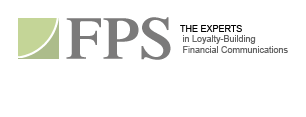 |
 |
| MAY 2009 |  |
What we do |  |
Work Samples |  |
FPS Resource Library |
|
E-Mail Seen as Cost-Effective Marketing Tool in Recession by Vince DiPaolo Recent industry research continues to point to the power of e-mail as a marketing tool for financial services companies — and offers tips on making the most of your e-mail efforts. ClickZ, an online provider of information on interactive marketing, recently surveyed its readership on how the economic downturn is affecting response rates and other benefits typically associated with business e-mail marketing. According to the survey, marketing and sales staff is being trimmed nearly everywhere and at every level. Those remaining are being asked to grow their customer base and cross-sell more services to existing customers despite having fewer support resources. The ClickZ survey also indicates that e-mail, with its lower cost, is being used in place of print-and-mail campaigns to enable marketers to continue communicating with target audiences despite budget reductions. Meanwhile, another recent study of business-to-business (B2B) e-mail marketing by consultants Econsultancy and R.O.EYE finds that 51% of marketers believe e-mail to be very cost effective, leading the way to other profitable channels such as paid search, landing pages and Web video. Also recently, in a study by Epsilon and ROI Research, 57% of respondents reported that when they know about or already do business with a company, receiving an e-mail from that company leaves them with a more positive impression. Customer-centric content is essential The importance of developing and delivering content that is customer-centric and consultative has been a central theme of MarketScope over the years. While e-mail can be an extremely affordable client loyalty and brand enhancing tool, it won't be effective unless the content is perceived by recipients as having high value and it delivers actionable data tracking for your sales and marketing teams. The importance of solutions-focused content is even more critical now, as business clients look for "news they can use" to keep their heads above water in a tough economy. Strategies to make e-mail effective In an October 2008 white paper, "Benchmark Your Email Organization," Forrester Research outlined some e-mail strategies that can stretch your marketing dollars and measurably lift response rates. Forrester surveyed 260 e-mail marketers, from companies both large and small and of varying industry sectors. While Forrester revealed substantial room for improvement, it also found that when companies take full advantage of best practice strategies and technological advances, and when measurement and follow-through were consistently employed, marketers reaped up to a 700% return on their e-mail marketing investment. Given the general belt-tightening being required today from marketing departments, Forrester suggests that staff fully utilize outsource e-mail providers. "E-mail service providers offer a range of e-mail services beyond deployment and delivery. Their tools are specially designed to facilitate testing and segmentation," the report says. Small marketing teams or those with rapidly growing programs that turn to outsource suppliers to help with e-mail strategy and analytics can typically expect "increased order value, revenue and ROI," the Forrester report concludes. Today we hear much about rich media, or Web 2.0, which is a more highly interactive, multi-media form of marketing. Despite the glitz and appeal of Web 2.0, e-mail remains by far the most widely used delivery channel to get interactive messages delivered to relevant recipients, to track the response rates and to close more sales. LinkedIn and previous edition links One way to get more mileage from your e-newsletters and other online content is to post them on a relevant group message board within LinkedIn.com, suggests Karen Gedney, award-winning creative director and copywriter. Another low-cost, high-value means of increasing the readership and shelf-life of your e-newsletter is to include in each edition a link to previous editions. The link might be titled something like "What you missed in previous editions." Our experience has been that over time the number of click-throughs to past editions often matches the number of hits recorded when the newsletter is first published. Starting slow OK, but be compelling While you may not yet be ready to employ all of these e-mail marketing practices, you can start with one or more.Even with a database of just a few hundred e-mail addresses, by delivering compelling, relevant, solutions-based content, you can immediately begin reaping e-mail's marketing benefits. Your relationship managers alone likely have access to enough client e-mail addresses to get started. FPS once helped a client build an initial e-mail address list of just a few hundred names. Over several years an aggressive internal e-mail address-gathering campaign combined with a solutions-oriented e-newsletter program grew the institution's database to more than 14,000 e-mail addresses. These are difficult times for financial institutions. You need to keep in mind, however, that your business customers are facing incredible challenges, too. That is why now, when clients are looking for the answers they need to survive, is the perfect time to reach out to them. Offer advice, guidance, business solutions and consistent communications to let them know your bank is there for them. The reward? According to a study by Harvard University, just a 5% improvement in customer retention can translate into as much as an 85% increase in profitability. . . . If you are not already a MarketScope subscriber, please request your own free monthly edition. |
|